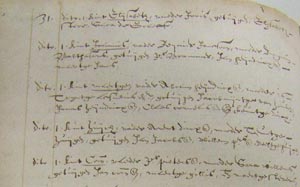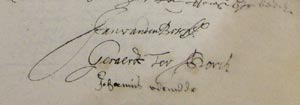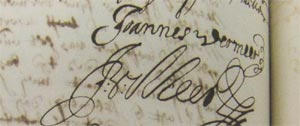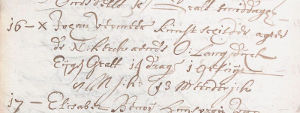Since Vermeer's recovery in the mid-nineteenth century by the French left-wing politician and art critic Thoré-Bürger, generations of art historians have lamented the paucity of documented facts about the artist's life. Although this lacuna is unfortunate, it should be remembered that many Dutch artists, includingthe Netherlands' most illustrious landscape painter, Jacob van Ruisdael, have fared no better. Most, much worse. In fact, we know almost nothing about the great part of Dutch painters, many of whom, reputed themselves artisans rather than artists and would have been surprised by the recognition accorded to them in modern art history. Few painters were considered important enough to write about. The limited amount of Dutch art literature that existed focused primarily on art theory, rather than on the private lives of the artists.
 Thoré-Bürger
Thoré-BürgerOccasionally, other motives may explain the scarcity of written testimony about key events in the life of Vermeer. For example, not a single piece of evidence testifies directly to Vermeer's largely accepted but undocumented conversion to Catholicism. However, given that Roman Catholic priests operated in utmost secrecy, it is not difficult to understand why notations of the artist's conversion have not survived.
Vermeer is mentioned twice in diary entries of high-minded members of the cultural elite, and later his name appeared in a catalogue entry of a sale of paintings along with a succinct description of the work. Fortunately, the Dutch were meticulous record-keepers who compiled lists of every detail that might make the legal workings of complex mercantile society work more efficiently. A wealth of legal depositions and a good number of carefully compiled inventories have survived, which help us illuminate the dark corners of the lives of Dutch painters.
The story of historical research regarding Vermeer began long ago. The body of knowledge about Vermeer's life, which had circulated in scholarly literature, became available to the general public when Dutch art historian Albert Blankert published all known Vermeer-related documents in his monographic study of Vermeer in 1975. Albert Blankert, Vermeer of Delft: Complete Edition of the Paintings (London; Phaidon Press, 1978). Moreover, Blankert's volume furnished the first realistic picture of Vermeer as he was seen by his contemporaries: a well-known painter within Delft and its immediate environs.
John Michael Montias, an American economist, is credited with "completing" Vermeer's portrait through his research in the Delft Municipal Archives, Montias analyzed every shred of evidence concerning the Delft master, or any individual who had any form of contact with him. Montias worked with passion and discovered new, important documents. "Through his scrupulous analysis of various documents ranging from notes and letters to receipts and legal papers,…Montias "unveiled the layers of Vermeer's life, a favorite and enigmatic artist of his, and one of the world's most mysterious. His work opened the door for a new genre of art history in which artists were analyzed in the context of their social and economic surroundings and not merely their"works. "Kathryn Shattuch, "John Montias, 76, Scholar of Economics and of Art, Is Dead," The New York Times, August 1, 2005, accessed November 15, 2023.

John Michael Montias
Montias "'decided to attack the archives in Delft, knowing that they had been scoured for information on Vermeer,' recalled Otto Naumann, an art dealer based in Manhattan who studied under Montias. 'With the confidence that only a true genius can possess, he decided that he could do better, without first learning Dutch. It took Montias one week to find an unpublished document that mentioned Vermeer and but another to decipher it, Mr. Naumann said.'"Kathryn Shattuch, "John Montias, 76, Scholar of Economics and of Art, Is Dead," The New York Times, August 1, 2005. A Delft archivist recounts that Montias was often the very first to enter and the last to leave the archive's premises.
Montias unearthed over 454 documents pertaining to Vermeer and his family which had remained undisturbed for centuries cross archives in no fewer than 17 Dutch and Belgian cities. In 1989 he published Vermeer and His Milieu: A Web of Social HistoryJohn Michael Montias, Vermeer and His Milieu: A Web of Social History (Princeton, NJ: Princeton University Press, 1989),. which revealed that Vermeer's grandfather was a convicted counterfeiter; that his grandmother ran illegal lotteries; and revealing that Vermeer fathered 13 children and died destitute at 43. From an art historical point of view, his most important discovery was that (in his own words), "Vermeer had a patron, Pieter Claesz. van Ruijven, who bought paintings from him year after year and to whom his wife (who had the money) left a conditional bequest in her testament. But the contribution that I most enjoyed making was to reconstruct the hitherto obscure lives of various members of his family, including his mother's father who participated in a counterfeiting scheme in which his partners were beheaded."
When Montias began his work, he intended to write a comparative study of Dutch art guilds. Delft was to be his first working station. However, he quickly realized that a comparative study required a preliminary study in depth of at least one guild. Consequently, he focused on the Guild of Saint Luke in Delft, leading to his book on the subjec, Artists and Artisans in Delft, a Study of the Seventeenth Century (1982).John Michael Montias, "Artists and Artisans in Delft: A Socio-Economic Study of the Seventeenth Century," Journal of Cultural Economics 7, no. 2 (December 1983): 91-98. In the course of this research, he realized that, contrary to his expectations, previous scholarship on Vermeer's life had not exhausted the subject. In the late 1970s and the early 1980s, Montias combined research on Vermeer with research on other members of the guild, encompassing artists and artisans alike (glassmakers, embroiderers, faienciers, etc.).

(Gemeentearchief Delft) on Oude Delft
However important these documents may be, they cannot convey a complete picture of a citizen's character. "The material evidence of Dutch artists of the seventeenth century consists of depositions, business transactions, and other documents drawn up by notaries and municipal clerks that force us to consider the person's life from a particular angle, closer to his adversarial than to his amicable relations to his fellow "en."John Michael Montias, Vermeer and His Milieu: A Web of Social History (Princeton, NJ: Princeton University Press, 1989), xv. Thus only a shadowy image of his character emerges, yet still far more informative than having none at all. According to Montias, Vermeer seems to have lived a fairly retired life, with his wife, a dominant mother-in-law, and his numerous children, predominantly girls. Other scholars have painted different pictures of Vermeer's personal and professional life.
We hope that the samples of Vermeer-related documents below may offer insights into the unique aspects of civic life in Delft and, perhaps, some of the artist's character is revealed in the four signatures which appear in them. The photographs were taken by Adelheid Rech with courtesy of the Erfgoed Delft Stadsarchief (Delft Archives).
The accompanying explanatory text is sourced from Vermeer and His Milieu: A Web of Social History. The Dutch transcriptions come from Montias's work, Vermeer en zijn milieu. Baarn 1993.
The smaller images below show details from significant sections of the larger image above. To view the images in a larger format, please click on them
1632: Vermeer's baptism
John Montias's research reveals that Vermeer's baptismThe entry for Vermeer's birth in October 1632 and the entry for the famous Delft scientist and "father of microscopy" Antonie van Leeuwenhoek's on the same month ( November 4) appear on the same page of the baptismal records book of the Nieuwe Kerk (New Church), He was registered as "Thonis Philipszoon." was somewhat of a break from the past. The ceremony was witnessed by a certain Pieter Brammer (a skipper), Jan Heijndricxzoon (a framemaker), and Maertge Jans. Neither Bramer nor Heijndricxzoon were likely family members, an unusual occurrence. The only certain family member was Maertge Jans, Reynier's sister. In the other baptisms of Reynier's siblings all were witnessed by close relatives.
Another anomaly was the choice of Vermeer's first name, Joannis. Joannis was the Latinized form of Jan that Roman Catholics and upper-class Protestants favored. Reynier may have had ambitious plans for his first male child.
All traces of Vermeer have vanished between his baptism in October 1631 and his betrothal in April 1653. About all we can say with near certainty is that young Johannes grew up in his father's inn, first at The Flying Fox on the Voldersgracht, then at the Markt (Great Market Square) in Mechelen, with only one sibling, a sister twelve years older than himself. The rest is speculation.John Michael Montias, Vermeer and His Milieu: A Web of Social History (Princeton, NJ: Princeton University Press, 1989), 98.
Montias entry 136
Dutch transcription (Montias 1993, 136):
31 October, 1632.
dito. 1 kint Joannis, vader Reynier Janssoon, moeder Dingnum Balthasars, getuijgen P[iete]r Brammer, Jan Heijndricxzoon & Maertge Jans.
(Delft G. A., New Church, "Doopboek" no. 12; first published by Obreen F.D.O. Obreen, "Iets over den Delftschen schilder Johannes Vermeer," Archief voor Nederlandsche Kunstgeschiedenis, vol. 4 (1881–1882), 289–303. 1881, 4: 291.)
1653: Leonaert Bramer's appeal to Maria Thins
On the evening of April 4, 1653, the well-known Delft painter, Leonaert Bramer (1596–1674), a Roman Catholic himself, and a Protestant sea captain, Bartholomeus Melling,Melling had been a captain and sergeant in Brazil, and was later an ensign in the service of the States General of the Dutch Republic. He probably belonged to the dominant Reformed religion so Montias suggests he may have represented the Protestant and Bramer the Catholic side in the confrontation with Maria Thins. called on Maria Thins. They had with them a Delft lawyer named Johannes Ranck. This party had come to convince Maria that the young up-and-coming artist was a good match for her beloved daughter Catharina. Maria's sister was also present giving support and sympat"y. "The visitors had come to ask Maria to sign a document permitting the marriage vows to be published. Maria replied that she would not sign such an act of consent. Despite this a subtle distinction—she would put up with the vows being published—,she said several times that she wouldn't stand in the way of this. In other words, she didn't welcome the marriage but she wouldn't block it.
"Next morning the notary Ranck drew up a deed attesting to Maria Thins' sufferance of the vows being published, and this was witnessed not only by Bramer and Melling but by a man named Gerrit van Oosten and Delft lawyer Willem de Langue, both of whom had frequent dealings with the Bramer and Vermeer families. "John Michael Montias, Vermeer and His Milieu: A Web of Social History (Princeton, NJ: Princeton University Press, 1989), 216
Montias entry 249
Dutch transcription (Montias 1993, 249):
5 \d\sFebruary\s\d 1653.
Op huijden den 5den april 1653 compareerde voor mij Johannes Ranck openbaer notaris…binnen der stadt Delft residerende in presentie van de ondergeschreven getuijgen, Capiteyn Melling out ontrent LIX jaeren ende Leonart Bramer schilder out ontrent LVIII jaeren beyde burgers alhier, die verclaerden ende attesteerden ten versoucke van Jan Reijniersz. ende Trijntgen Reijniers waerachtich te weesen dat sij getuijgen neffens mijn notaris gisteren avont sijnde den IIII den deser sijn geweest ten huijse aen ende bij de persoon van Joffrouwe Maria Tints woonende alhier…
[signed:]
B. Melling
W. de Langue
Leonaert Bramer
Gerrijt IJansz. van Oosten
Johannes Ranck notaris Anno 1653
akte 55
(Delft G. A. records of notary J. Ranck, no. 2012)
1653: Record of the marriage of Johannes Vermeer and Catharina Bolnes
5 en 20 April, 1653. Den 5en Apprill 1653: Johannes Ryniersz. Vermeer J[ong] M[an] opt
Marctvelt, Catharina Bolenes J[onge] D[ochter] mede aldaar.
[margin note left-side:] Attestatie gegeven in Schipluijden 20 April, 1653
5 and 20 April, 1653. In the "register of the persons who entered the holy marital state in the town of Delft, beginning with the year 1650, ending 'last' [31st] December 1656 ":
"Johannes Reijniersz. Vermeer, bachelor [living] on the Market Place; Catharina Bolenes,
young daughter [spinster], also there. "
[marginal note left-side:] Attestation given in Schipluij, 20 April, 1653."
Montias entry 250
1653: Vermeer and Gerrit Ter Borch witnesses an act of surety
Shortly after his marriage to Catharina Bolnes, Vermeer appeared before the notary to witness an act of surety together with the successful painter Gerrit Ter Borch (1617–1681), one of the finest genre painters of the Golden Age of Dutch painting. No other connections between the two artists can be established. In fact, when Montias discovered this document it was not even known that Ter Borch had ever set foot in Delft.The notary referred to Ter Borch as "Monsieur" a sure sign of his respect for the 36 year-old artist who was then at the height of his powers. Vermeer was not yet an accepted master of the Delft Guild of Saint Luke. As Vermeer had been married just two days earlier to Catharina Bolnes, it is possible that the elder painter had come expressly for the event.April 22, 1653
Johann van den Bosch, captain in the service of the States General, stationed in Den Briel, offers surety to enable Juffr. Dido van Treslong to collect a sum of 1,000 guilders due to her from the estate of the late Lord of Treslong, former Governor of Den Briel, which sum he, Van der Bosch, guarantees will be restituted if this proves necessary. Monsr Gerrit Terburch and Johan van der Meer witness this act of surety. The older painter signs Geraerdt Ter Borch, the younger Johannis Vermeer.
Montias entry 251
(Delft GA, records of Notary W. de Langue, no. 1695.)
1654: Vermeer is mentioned as a "Master Painter "
January 10, 1654, Vermeer is mentioned for the first time as Meester-schilder (Master painter) indicating he had by this time improved his professional and social status.Three pages. Page 3 (signatures), third line from below (text) + f.:
'Lambertus Morleth & Johannis
Vermeer M[eester]=schilder…'
[signed]:
Lambertus Morleth
Johannis Vermeer
Vrijenbergh, Notaris
1654
Montias entry 258
(Delft G.A. akten van notaris N[icolaes] Vrijenbergh, no. 2052.)
In the detail below "Vermeer Meester-schilder" is circled in light brown, further below is the painter's signature.
1655: Declaration concerning Johan van Santen with the signatures of Vermeer and his wife Catharina Bolnes
((The following is drawn from Montias, p. 134.) This document, discovered by Abraham Bredius a century ago, was dated December 14, 1655. "On this day, Sr. Johannes Reijnijersz. Vermeer, master painter," and his wife "Juffr. Catharina Bolnes," appeared before Notary Rota to guarantee a debt of 250 guilders, which the artist's father had contracted in 1648 from a sea captain named Johan van Santen. Nine years later, the interest on this debt was still being paid by Digna Baltens and Vermeer, having acquired the obligation after the death of Vermeer's father, Reynier. The "Sr." (signior or seigneur) preceding Vermeer's name signifies the artist's rise in social status. It will be recalled that Vermeer's father was never addressed in such a manner in any of the numerous documents pertaining to him.
Montias entry 262
Dutch transcription after the English explanation (Montias 1993, 262):
14 december, 1655. Op huijden den xiiiien December xviC vijfenvijftich, Compareerden voor mij Govert Rota openbaer Notaris… Sr. Johannes Reijnijers. [crossed out: Vosch] Vermeer Mr. schilder, ende Juff. Catharina Bollenes, wonende binnen deser stadt, sijne huijsvrouwe, Te kennen gevende ende verclarende sij comparanten, dat de E. heer Johan van Santen, Cap[itey]n vant Orange Vendel schutters, binnen deser stadt opten vijftien* [correct: 5] December xvi C. Achtenveertich sich selven, borge ande mede principael onder behoorlijcke renunchiatie hadde geconstitueert,…
[signed:]
Johannis Vermeer
Catharina Bolnes
M[aerten] Wigant [witness]
Pieter de Koninck [clerk]
G. Rota [notary]
(Delft G. A., records of Notary J. Ranck, no. 1986, vol. 257.)
1657: Vermeer and his Wife Catharina contract a loan of 200 guilders from Pieter van Ruijven
This document testifies to the first certain contact between Vermeer and his future patrons, Pieter van Ruijven. Van Ruijven lent Vermeer and Catharina 200 guilders at an extremely low interest rate, which, in the opinion of John Montias, may have been an advance towards the purchase of one or more paintings.30 November, 1657. [200 guilders on loan by Pieter Clasz. van Ruijven]
Op huijden den lesten November anno XVIC sevenvyfftich, Compareerden voor my Joan van Ophoven openbaer Notaris…mitsgaders voorden naegenoemde getuygen Johannis Reyniersz. Vermeer schilder, ende Catharina Reyniers Bolnes syne huysvrou …
[signed:]
Johannis Vermeer
Catharina Bolnes
(T. v. Hallitt ? 1657)
Albertus Bruijningh [clerks as witnesses]
Joan van Ophoven, Notaris, 1657
Montias entry 271
1672: Johannes Vermeer leases "Mechelen "
Vermeer leases the house/inn called "Mechelen," situated on the north side of the Markt (Market Place) and on the southwestern corner of the Oudemanshuis steegje, to Johan van der Meer (an apothecary) for the next six years, starting on the first of May of the present year, at a rate of 180 guilders per year.
This document demonstrates Vermeer's transition to a Latin style of writing and his adoption of the Latinized first name "Joannes," possibly reflecting his desire to align with contemporary cultural trends.
[signed:]
Joannes Vermeer
F. Boogert
(akten van notaris F. Boogert, no. 2008, first published Bredius 1910, 62:)
Montias entry 340
1675: Vermeer's burial in the Oude Kerk
The register of the persons buried in the Oude Kerk contains an entry for 15 December, which states: "Jan Vermeer, an art painter living on the Oude Landendijck, buried in the church, leaving behind 8 underage children." The register of graves further states that "in December 1675, Johan Vermeer was laid in his grave and the previously mentioned infant ('baerkint') was placed atop the coffin of the aforementioned Vermeer." It should be noted that Vermeer's infant was buried earlier, on 27 June 1673.John Michael Montias, Vermeer and His Milieu: A Web of Social History (Princeton, NJ: Princeton University Press, 1989), 216 https://amzn.to/3DC1BFwMontias entry 357
15 en 16 december, 1675. Onder de datum 15 december, 1675:
Jan Vermeer kunst schilder aende Oude Langedijk in de kerck
[marginal note at the left side:]
8 m[ind]e[r]j[arige] kind[eren]
(Delft, G.a. Register van de 'Personen die binnen deser Stad Delf overleden ende in de Oude Kerck als oock daer buijten begraven sijn tsedert den 19 Julij 1671')
1675: Vermeer's family leaves nothing to the Camer van Charitate
"On December 16, 1675, the day Vermeer's coffin was placed in the family grave, an inscription was made under his name in the book recording death notations to Delft's Camer van Charitate. The inscription in Dutch read: "niet te halen," which may be translated as "nothing to get." The reference was to the box that was normally sent to the house of the deceased. In this box, his family or heirs were supposed to deposit his "best outer garment" or a suitable donation for the poor. Why was no donation made after the artist's death? Was it because the widow, burdened with so many children, was too poor? Or because the family was Catholic and did not wish to contribute to an organization run by Calvinists?"John Michael Montias, Vermeer and His Milieu: A Web of Social History (Princeton, NJ: Princeton University Press, 1989), 337 According to Montias, the failure to donate was probably rooted in Catharina's insolvency, declared a few moths later.John Michael Montias, Vermeer and His Milieu: A Web of Social History (Princeton, NJ: Princeton University Press, 1989), 337.16 December, 1975. 16 dito (second from below):
Johan Vermeer kunst Schilder aen de Oude Langendijck
niet te haelen [= note right-side]
O:K: [Oude Kerk]
Montias entry 358
December 16, 1675: Vermeer's funeral casket is held by 14 pallbeares
The former archivist Bas van der Wulp of the Erfgoed Delft, the city’s cultural heritage department, has recenty discovered a burial record of the Oude Kerk that reveals previously unknown details about the funeral of Vermeer on December 16, 1675. Notably, Vermeer's coffin was carried by fourteen bearers, and the church bell was rung, indicating a lavish ceremony.The discovery of the funeral note can be considered remarkable, according to the Prinsenhof Museum, in light of the extensive research on Vermeer done by so many scholars for over a hundred years.Van der Wulp himself, who has worked for the archive for 45 years, had never made such a discovery previously.
Interestingly, Vermeer's brother-in-law, Willem Bolnes, and his mother-in-law, Maria Thins, also received similarly grand funerals. Maria Thins' funeral even included two bell tolls instead of Willem and Vermeer's one. These observations lead to the suspicion that Maria Thins may have funded Vermeer's funeral. Van der Wulp suggests that Thins intended to cover the funeral costs for her daughter's sake, possibly unaware of Vermeer's dire financial state, which had deteriorated significantly following the Rampjaar (Disastrous Year of 1672), leaving him penniless.




















